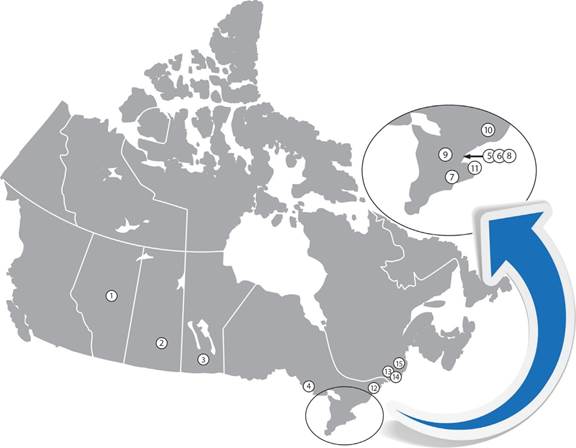Code of Practice to reduce emissions of PM2.5 and VOCs from iron, steel and ilmenite sector: chapter 1
1.0 Introduction
1.1 Background
The iron, steel andilmenite sector is subdivided into three sub-sectors: integrated mills, mini-mills and ilmenite smelting facilities. In Canada, the integrated steel mill sub-sector consists of 4 plants, all located in Ontario. There are 10 mini-mills located in Alberta (1), Saskatchewan (1), Manitoba (1), Ontario (5) and Quebec (2). Worldwide, there are only 5 ilmenite smelting facilities, 1 of which is located in Quebec. The 15 facilities that make up the sector in Canada are listed in Table 1.1 and shown in Figure 1.1. Integrated mills commonly include cokemaking, ironmaking, basic oxygen furnace steelmaking and steel finishing activities, while the mini-mills include electric arc furnace steelmaking, direct reduction ironmaking (DRI) and steel finishing. Ilmenite smelting facilities produce titanium slag and may produce iron as a by-product.
In October 2012, federal, provincial andterritorial environment ministers took action to better protect human health and the environment by endorsing and implementing the new Air Quality Management System (AQMS). The AQMS includes Canadian Ambient Air Quality Standards for fine particulate matter and ground-level ozone, Base Level Industrial Emissions Requirements (BLIERs) and local AirZone Management by the provincial/territorial jurisdictions. For the iron, steel and ilmenite sector, BLIERs were developed for NOx, SO2 and total particulate matter (TPM), and it was recommended that a code of practice (Code) be developed to help reduce fugitive emissions of TPM from all sub-sectors and volatile organic compounds (VOCs) from integrated mills and mini-mills.
| Facility No. | Facility Company/Name | Location | Sub- sector | Liquid Steel Capacity (tonnes)TableNotea |
|---|---|---|---|---|
| 1 | AltaSteel | Edmonton, AB | MM | 400 000 |
| 2 | Evraz Inc. NA | Regina, SK | MM | 1 100 000 |
| 3 | Gerdau Ameristeel Manitoba | Selkirk, MB | MM | 450 000 |
| 4 | Essar Steel Algoma | Sault Ste. Marie, ON | IM | 4 000 000 |
| 5 | ArcelorMittal Dofasco | Hamilton, ON | IM | 4 400 000 |
| 6 | U.S. Steel Canada - Hamilton Works | Hamilton, ON | IM | 2 570 000 |
| 7 | U.S. Steel Canada - Lake Erie Works | Nanticoke, ON | IM | 2 400 000 |
| 8 | Hamilton Specialty Bar Corp. | Hamilton, ON | MM | 400 000TableNoteb |
| 9 | Gerdau Ameristeel - Cambridge | Cambridge, ON | MM | 320 000 |
| 10 | Gerdau Ameristeel - Whitby | Whitby, ON | MM | 1 000 000 |
| 11 | ASW Steel | Welland, ON | MM | 180 000TableNotec |
| 12 | Ivaco Rolling Mills | L’Orignal, ON | MM | 450 000 |
| 13 | Arcelor Mittal Contrecoeur | Contrecoeur, QC | DRM | 2 000 000 |
| 14 | Arcelor Mittal Contrecoeur - Ouest | Contrecoeur, QC | MM | 650 000 |
| 15 | Rio Tinto - Fer et Titane Inc. | Sorel-Tracy, QC | IS | 500 000TableNoted |
Legend:
- MM: Mini-mill
- IM: Integrated mill
- DRM: Mini-mill (including direct reduction ironmaking)
- IS: Ilmenite smelting facility
Facility numbers refer to locations shown in Figure 1.1.
Figure 1.1: Steel Plant Locations by Province (2013)

Description of Figure 1.1
Figure 1.1 is a map showing the location of the 15 steelmaking facilities across Canada with numbers 1 to 15. The southern Ontario area is shown in a window with a magnified scale to show the location of 7 plants. See Table 1.1 above for locations.
1.2 Objective, Scope and Development
The objective of the Code is to identify and promote best practices in order to facilitate and encourage continual improvement in environmental performance of fugitive TPM and VOC emissions from steel mills. The voluntary Code is intended to be a resource forthe Steel Sector, regulatory agencies and the general public. A commitment by companies to implement the recommendations found in the Code does not remove obligations for such companies to comply with all applicable laws and regulations.
The Code identifies sources of fugitive TPM and VOC emissions and makes recommendations to reduce these types of emissions. The Code is complementary to the existing published steel codes of practiceFootnote1.
Recommendations are based on best available techniques for pollution prevention and control. Although the recommendations areintended to be clear and specific, they are not intended to discourage the use of alternative technologies and practices that can achieve an equivalent or better level of environmental protection. The Code does not take into consideration practices that would require an existing facility to make major technological changes. In designing a
new facility, other technologies can be taken into consideration to further minimize emissions, such as non-recovery (or heat-recovery) cokemaking and DRI technology.
The Code was developed by Environment and Climate Change Canada inconsultation with a broad range of stakeholders. Relevant information from various sources was considered in the development of the recommendations in the Code. Sources included technical and scientific journals, reports and literature from provinces, Environment and Climate Change Canada, the Canadian Council of Ministers of the Environment, the United States Environmental Protection Agency, the European Union, the United Nations Economic Commission for Europe, the United Nations Environment Programme, and the World Bank.